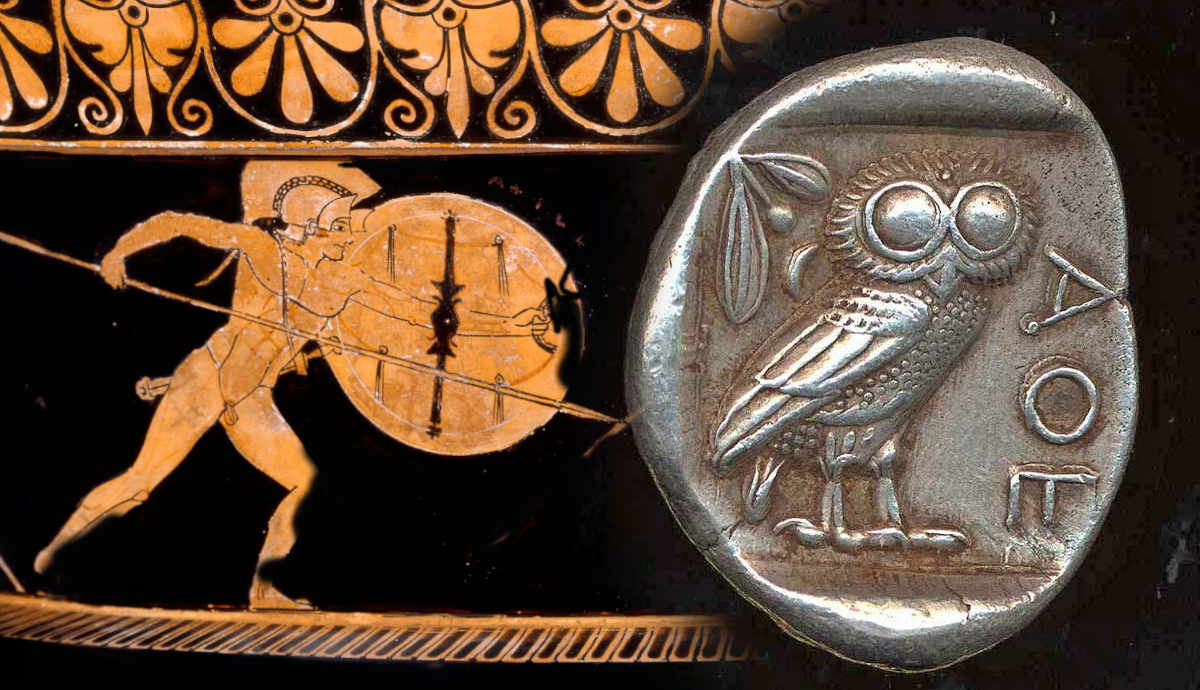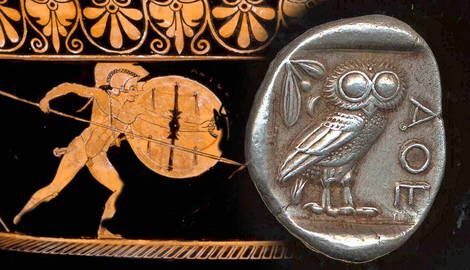
After the second attempt by the Persians to conquer Greece, it was clear that more defensive political structures needed to exist in order to guarantee an effective counter to the still mighty Persian Empire.
Thus in 478 BCE, the Delian League was formed. Although some elements of it existed on the Greek mainland, and spread over the Ionian city-states in Asia Minor it was largely an alliance of city-states throughout the Aegean Sea. The Delian League became so dominated by Athens that it eventually became known as the Athenian Empire.
Formation of the Delian League

In 490 BCE and again ten years later, Greece was invaded by the world’s first superpower — the Persian Empire. Against unbelievable numerical odds, the Greeks managed to beat back the invaders. Fearing that the Persians would mount further invasions, Athenian statesmen and generals such as Themistocles and Aristides, sought to evolve the loose alliances between the Greek city-states, and form defensive leagues with binding rules.
By early summer in 477 BCE, the people of the Aegean and surrounds were gathering to discuss the formation of a new league. For many, it represented a simple defensive pact to protect against future Persian aggression, and for some it represented an opportunity to gain power. Thus, the Delian League was born.

Centered on the sacred island of Delos — the mythical birthplace of Apollo and Artemis —, held in equal importance by Dorian (Greece) and Ionian (Asia Minor) Greeks, the league was formed with around 150 city-state members, and with Athens as the designated leader through which military actions would be conducted. The treasury for the Delian League would be held on Delos, and every year, the member states would arrive on the island to pay their share of the tribute. Each city-state contributed financially, with a few contributing directly to the naval capability by adding their own ships to the combined fleet.
Athens Establishes Dominance

In 467 BCE, the island of Naxos attempted to secede from the League. The reasons for this are unknown, but the League responded with a heavy hand. The Athenians besieged Naxos and beat the city into submission, which was then enslaved. This sent a very clear message that defections or any attempt to leave the union would result in severe consequences. This had the effect of keeping the League unified, but it also set Athens up as a master who would use force on its own members if necessary.
This precedent developed further upon the dispute between Athens and the island of Thassos over the use of trading ports, as well as a highly profitable mine. The dispute led to Thassos revolting, and seceding from the League. As with Naxos, the Thasians would suffer a similar fate. Although the island resisted the Athenians for three years, Thassos was eventually reduced, and its population forced to pay tribute.
Actions such as these led to fear among the member city-states, and a realization that Athens was not just willing, but quite happy to enforce compliance via force.
The Delian League Flexes

The Delian League was formed for several reasons, all of them involving Persia (The Achaemenid Empire). The Greeks wanted reparations and revenge for the Persian invasions of Greece. They also wanted to liberate Hellenic cities still under the yoke of the Persian Empire.
Upon discovering that the Persians were building another fleet for a possible third invasion of Greece, the Delian League acted, and thus began the first of the alliance’s military expeditions, culminating in a significant victory at the Battle of the Eurymedon in 466/465 BCE.
Five years later, the Delian fleet would strike again, attempting to capture Cyprus, and then sailing south to unsuccessfully lay siege to the Egyptian city of Memphis. Even though the Egyptian campaign was disastrous, the Greek city-states began to flourish, especially those based on the Aegean islands. Trade boomed, and membership of the league expanded to around 200 members.
The Delian League also sought to expand geographically. Focusing attention northwards, the League established a colony on the border with Macedon. Unhappy with Greek expansion, the Thracians defeated the Athenian forces at the Battle of Drabescus.
Essentially a naval entity, and despite significant success against the Persians, the Delian League would not have the continental reach to successfully challenge powers to the north of Greece.
Conflict and Consolidation

In 464 BCE, a massive earthquake struck the Peloponnese, and served as a catalyst for a helot (slave) revolt. Sparta requested aid in putting down the revolt, and Athens sent 4000 hoplites. Sparta received aid from other city-states, but rejected the Athenians. As a result, Athens withdrew from the original Hellenic league (which included many allies of Sparta), and allied itself with traditional enemies of Sparta. This brought Athens into conflict with nearby Corinth, which was an ally of Sparta.
Relations between Athens and Sparta would degrade even further, and would result in the (first) Peloponnesian War. From 460 BCE to 445 BCE, the Delian League was at war with the Peloponnesian League led by Sparta and Thebes.
Meanwhile in 455 BCE, while the Delian League was occupied with Sparta and her allies, a Delian League expedition to Egypt had failed miserably. The Persians won a significant victory, pushing the Greeks out of Egypt and weakening the Delian League, which encouraged the city-states of Erythrae and Miletus to revolt. These two city-states were eventually recovered and forced to house Athenian garrisons.

Furthering their power over the Delian League, the Delian treasury was relocated to Athens, and the Athenians used a vast amount of it to improve their own city, building temples and providing work for their own citizens.
In 449 BCE, after dealing a major defeat to the Persians at Salamis-in-the-Cyprus, the Delian League concluded the treaty of Callias and made peace with the Persians. The senior statesman of Athens, Pericles then invited representatives from all over the Greek world to a conference in Athens in an attempt to foster a pan-Hellenic alliance. Many city-states took part, while Sparta declined.
With the war with Persia ended, and the war with the Peloponnesian League taking the form of mainly land battles, the Athenian navy essentially became a police force, ensuring that the member states paid their tributes.
Seeking to expand influence further, the Athenians then attempted to institute a single currency. Several mints were closed in other city-states, but the efforts did not have the necessary effect, as the larger city-states had the power to continue minting their own coins.
Athenians also started emigrating to Delian League city-states upon encouragement by the Athenian government. This increased the reach of Athens and gave the city even more power over its allies by demanding the rights of their own citizens be taken into account in the local affairs of these city-states.
In 445/446 BCE, a treaty called “The Thirty Years Peace” was signed which officially brought an end to the conflict between Athens and Sparta. Ultimately, the treaty did not live up to its goals, and 14 years later, war broke out again between the two powerful leagues.
The (Second) Peloponnesian War

In 431 BCE, the tension between Sparta and Athens could no longer be contained, and the Delian League went to war against the Peloponnesian League.
The second phase of the Peloponnesian War was a far-reaching affair that saw action as far afield as Sicily. It was also a brutal affair, and many Greeks died not only from casualties inflicted in combat, but by disease. With Athens under siege, the Great Athenian Plague (430 BCE – 427 BCE) broke out and would claim a third of the entire population of Athens. It would also claim the life of the Athenian commander, Pericles, which dealt a huge blow to Athenian morale.
The tide of the war shifted back and forth for decades. In 427 BCE, the city-state of Plataea fell to the Spartans after a two-year long siege. The Athenians were again defeated at Megara and in Boeotia. However, the Athenians then achieved victory on the west coast of the Peloponnese at Pylos and then at Sphacteria, battles in which hundreds of Spartan hoplites were captured.

In 421 BCE, the Peace of Nicias concluded the first decade of fighting between the two leagues, but it would not last. Just seven years later, the Athenians sent an expedition to Sicily in an attempt to weaken Sparta’s allies there. Sparta declared that Athens had broken the truce, and the war resumed.
The expedition against Syracuse in Sicily was a disaster for Athens. They lost thousands of men, and their commander, Nicias. As a result of the failure, the political sphere in Athens erupted in turmoil, and power shifted from democracy to oligarchy, and then back again.

In 405 BCE, the Battle of Aegospotami ensured a Spartan victory. The Spartans led a surprise attack against the Athenian fleet, and the latter was almost completely wiped out. Athens was subsequently besieged, and the following year, the city fell, signaling an end to the Delian League.
The walls of Athens were destroyed, and a pro-Spartan oligarchy, the 30 tyrants, replaced the democracy of Athens. Sparta had finally won, and the days of Athens’ glory were over.
Delian League: Conclusion
The Delian League began a golden age for Athens, but was also the city’s downfall, as it drew the unwanted attention of the rival power of Sparta. Athen’s attempts to remain the most powerful city-state in the Greek world eventually ended with defeat at the hands of their long-time foes.
Like the Delian League, the Peloponnesian League would also have a limited lifespan, and Sparta would be eclipsed by Thebes after the Battle of Leuctra.
The Delian League demonstrated how a defensive alliance could become an imperial tool, and it showed how its constituent members could become subject to the demands of a single, powerful leader. Despite the two and a half millennia between then and now, these dynamics can still be seen as an unheeded warning today.










